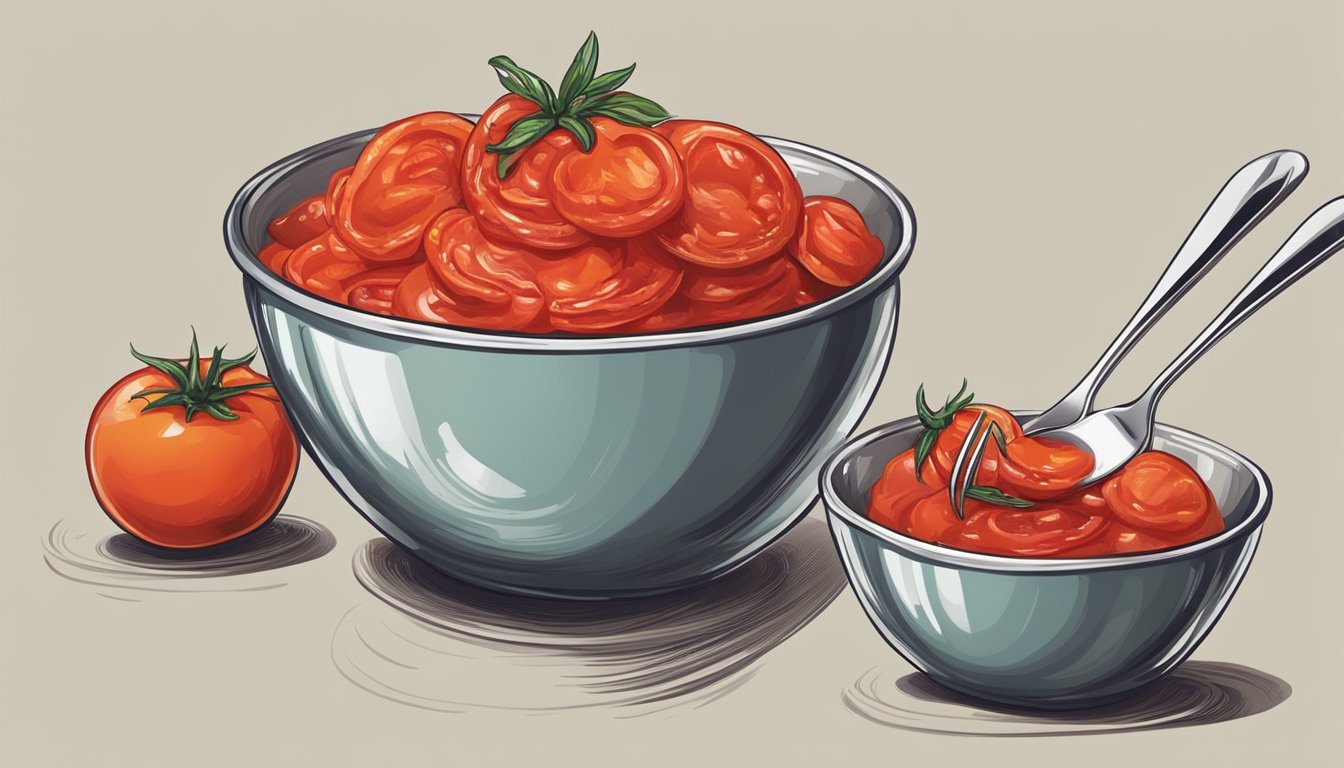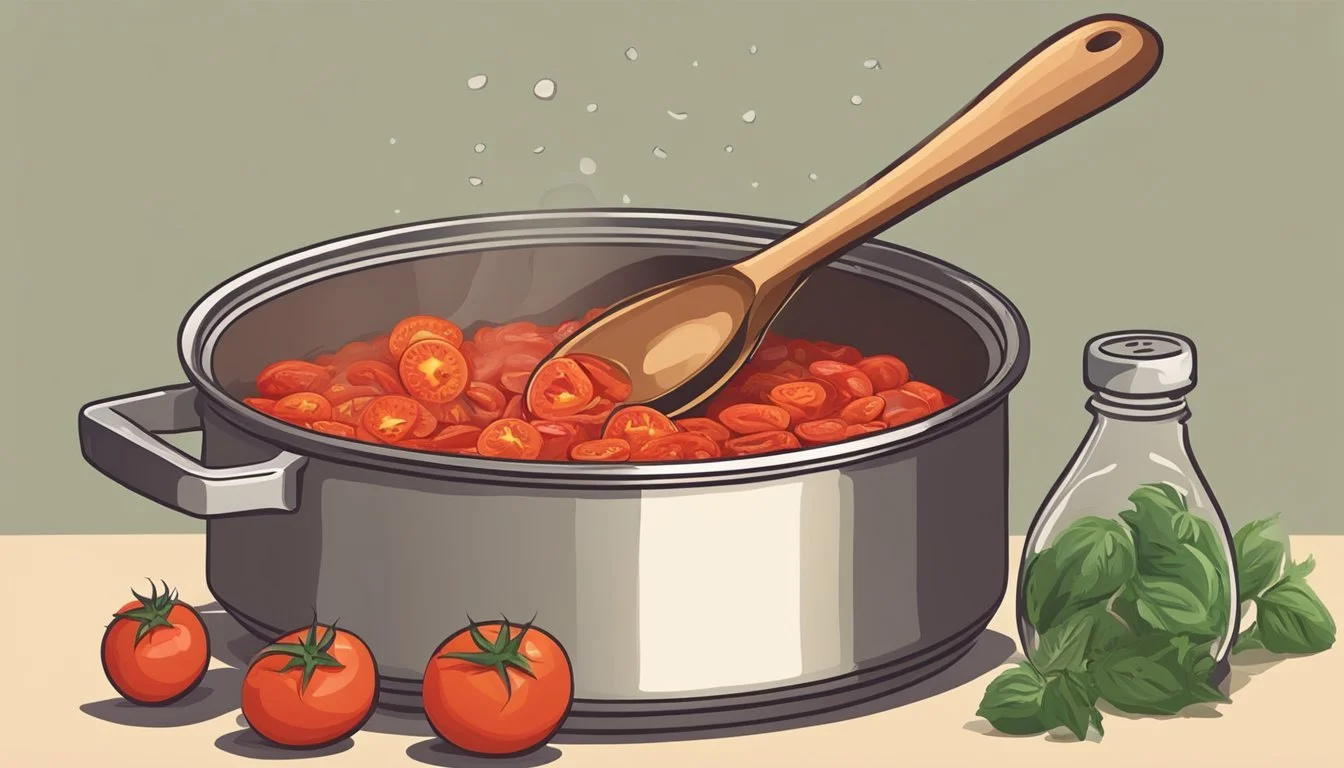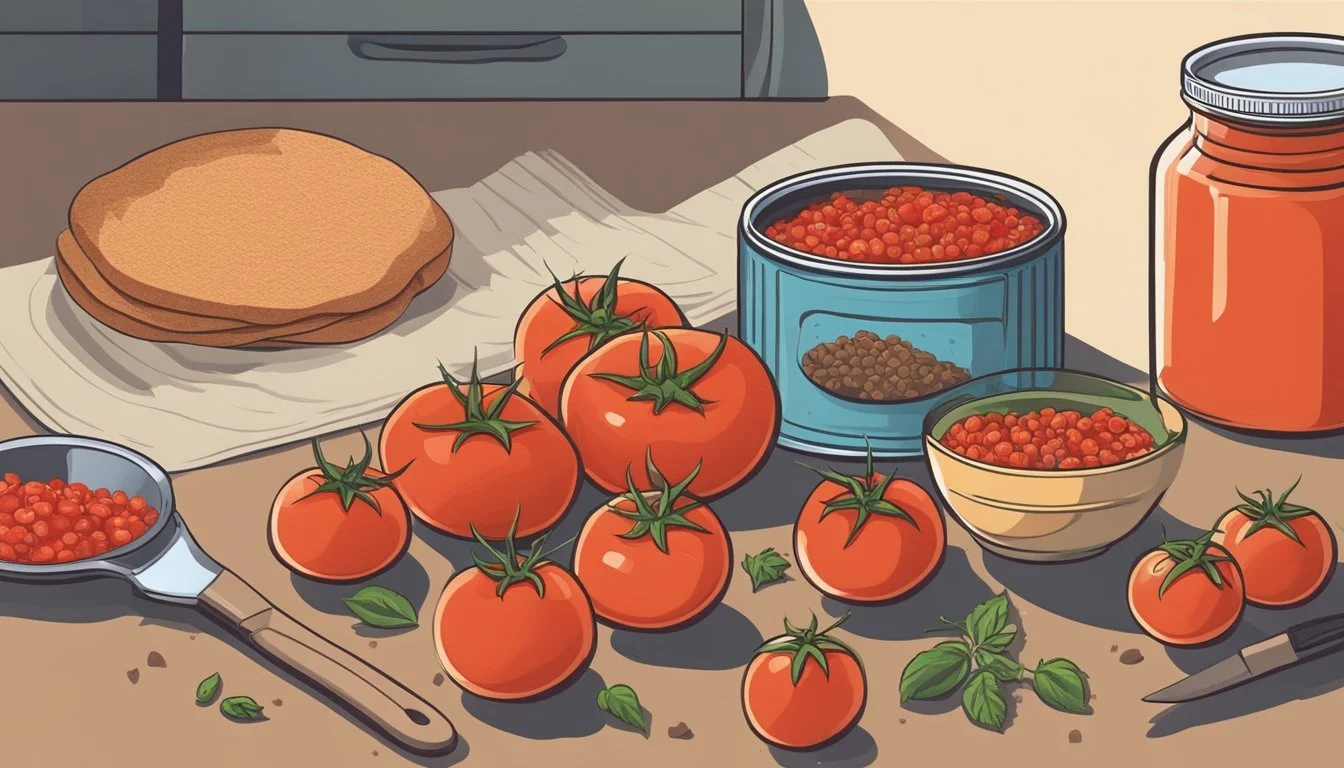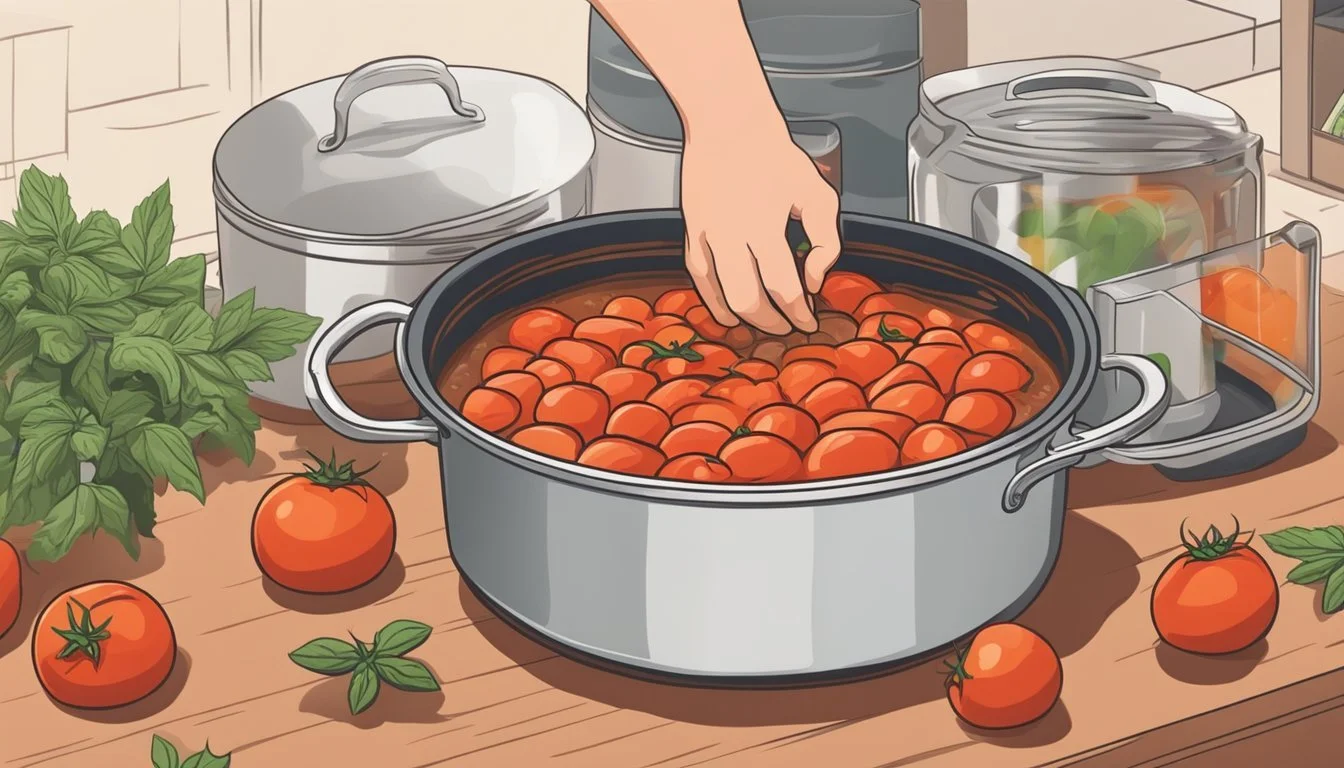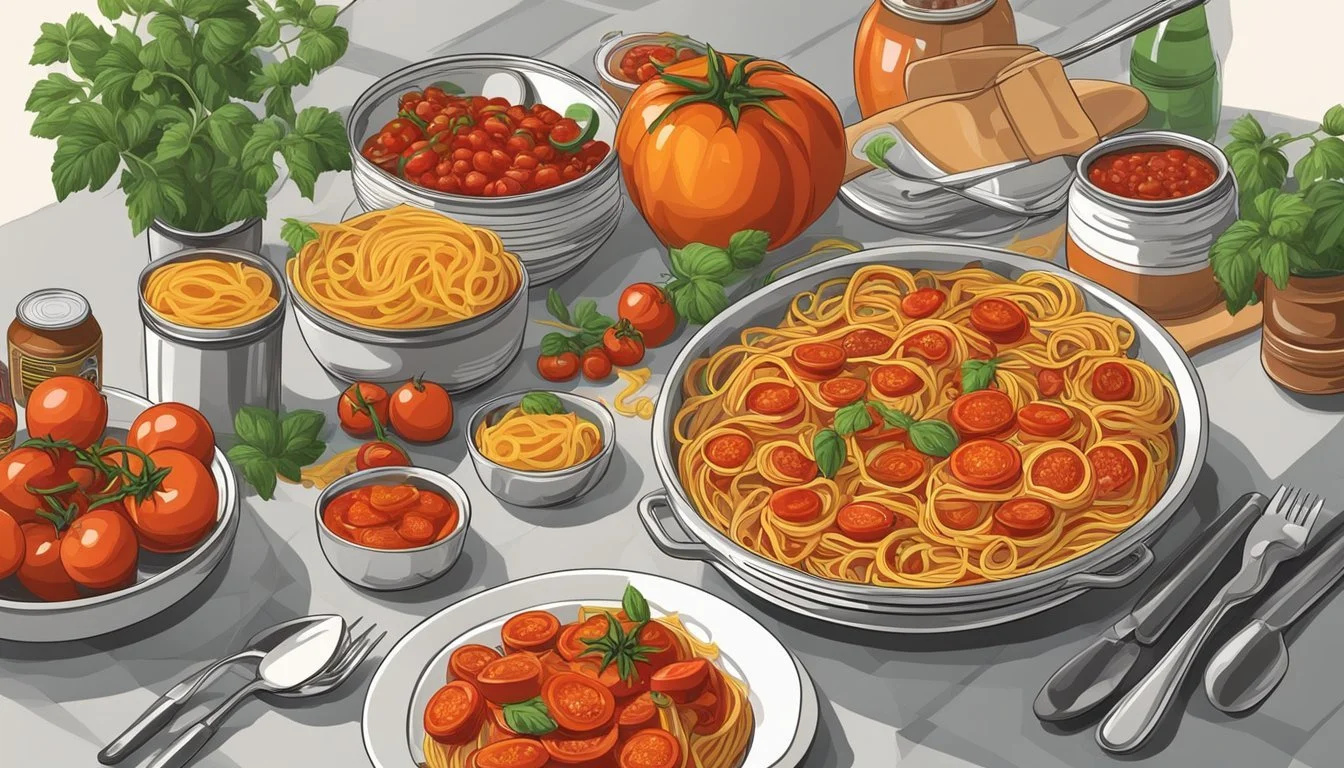How to Substitute Stewed Tomatoes for Crushed Tomatoes
A Simple Guide
Cooking often requires a certain level of creativity, especially when one doesn't have all the ingredients at hand. Substituting stewed tomatoes (What wine goes well with tomatoes?) for crushed tomatoes is a practical kitchen skill that can save a recipe when you're in a pinch. Stewed tomatoes, which are typically seasoned and cooked with other vegetables like onions, celery (how long does celery last?), and peppers, offer a softer texture and a slightly sweet, cooked flavor that can add depth to a variety of dishes.
While both stewed and crushed tomatoes start with the same fruit, their textures and flavor profiles differ. Crushed tomatoes are a vital ingredient in sauces, soups, and stews (What wine goes well with stews?), giving them body and a bright tomato flavor. They have a coarser texture than stewed tomatoes, but with a few adjustments, one can successfully use stewed tomatoes as a substitute in most recipes calling for crushed tomatoes.
When using stewed tomatoes in place of crushed tomatoes, it's important to consider the additional seasonings and vegetables present in stewed tomatoes that may affect the final taste of the dish. However, by adjusting spices and other ingredients, chefs can achieve a similar consistency and flavor, ensuring the success of their culinary creations without compromising on quality.
Understanding Tomatoes in Cooking
Tomatoes play a pivotal role in culinary arts, providing acidity, sweetness, and a robust base for various dishes. Understanding their contribution and types is essential for any cooking substitution, particularly when interchanging stewed and crushed tomatoes.
The Role of Tomatoes in Dishes
Tomatoes are a foundational ingredient in many recipes due to their versatility and ability to add complexity to a dish. Crushed tomatoes lend a chunky texture and rich flavor to sauces, soups, and stews. They are often used when a recipe calls for a rustic and hearty consistency. On the other hand, stewed tomatoes typically include seasonings such as herbs, onion, and bell peppers, and they have been cooked to a softer texture, which makes them ideal for dishes that require depth of flavor with less textural emphasis. Converting stewed tomatoes for crushed tomatoes requires consideration of their textural differences and the additional ingredients and seasoning in stewed tomatoes.
Varieties of Tomatoes Used in Cooking
There are numerous tomato varieties, each with unique characteristics lending themselves to specific culinary uses:
Fresh tomatoes: Incorporating a bright and tangy flavor, they are commonly used raw or cooked briefly to retain their fresh quality.
Plum tomatoes, including roma tomatoes, are denser and less watery, making them perfect for sauces like tomato sauce or pasta sauce due to their fewer seeds and firm flesh.
Whole tomatoes: Often canned, they provide a base for homemade crushed tomatoes by being hand-crushed to desired consistency.
Fire-roasted tomatoes: These bring a distinct smoky flavor useful for adding depth to salsas and Southwestern dishes.
Ripe tomatoes: These are best for immediate use in cooking or for creating a tomato puree with a sweet, intense flavor.
By knowing the types and uses of different tomatoes, cooks can confidently substitute between forms like stewed and crushed tomatoes for the desired outcome in their cooking.
Examining Tomato Textures
When substituting stewed tomatoes for crushed tomatoes, it's imperative to consider the texture spectrum of tomato products and their impact on the final dish.
Texture Spectrum of Tomato Products
Tomato products available on the market vary widely in texture. Here is a concise breakdown:
Whole Canned Tomatoes: They maintain most of their original texture, offering a firm structure that can be broken down as needed.
Crushed Tomatoes: Typically they have a chunky texture with a mix of small pieces of tomato flesh in a more finely pureed base.
Diced Tomatoes: These come in uniform pieces and provide a more consistent chunky texture throughout the dish.
Stewed Tomatoes: They are cooked with seasonings and often have a softer texture from the longer cooking process.
Tomato Puree: This product is smooth and thick, having been sieved to remove skins and seeds for a smooth consistency.
Tomato texture plays a crucial role in the viscosity and mouthfeel of a dish.
Impact of Texture on Recipes
The texture of tomato products will affect the outcome of a recipe in significant ways:
Consistency: A puree will lend a thick and smooth consistency to sauces, while crushed tomatoes will introduce a more varied texture.
Mouthfeel: Dishes that incorporate chunky textures, such as those made with diced or stewed tomatoes, offer a different mouthfeel compared to those using smoother products.
By understanding the texture differences between stewed and crushed tomatoes, one can make informed choices when substituting one for the other in recipes. It is essential to tailor the substitution to the desired texture of the final dish.
Comparing Crushed and Stewed Tomatoes
When adapting recipes, it's important to understand the characteristics of crushed and stewed tomatoes, as their nutritional profiles, textures, and flavors can influence the final dish.
Nutritional and Flavor Profiles
Crushed Tomatoes typically consist of peeled and crushed tomatoes, often with a touch of salt. They have a fresh flavor that resembles the natural taste of ripe tomatoes. Nutritionally, they are high in vitamins A and C and contain a rich source of antioxidants such as lycopene.
Stewed Tomatoes, on the other hand, are cooked with seasonings and sometimes with added vegetables such as onions, celery, or bell peppers. This not only enhances their flavor complexity but also slightly alters their nutritional content due to the additional ingredients.
Differences in Water Content and Consistency
The water content and consistency of crushed tomatoes and stewed tomatoes are significantly different, which can affect the texture of a dish.
Crushed Tomatoes have a higher water content and a more fluid consistency, providing body to dishes like soups and sauces without making them too thick.
Stewed Tomatoes are typically cooked down and have less liquid, resulting in a thicker consistency that is more suitable for hearty stews and casseroles.
Consistency Crushed Tomatoes Stewed Tomatoes Water Content High Lower Body More Fluid Thicker
Substituting Based on Recipe Type
When substituting stewed tomatoes for crushed tomatoes, one must consider the type of recipe.
For soup or marinara sauce, where a lighter, more tomato-forward flavor is desired, crushed tomatoes are ideal. They introduce a fresher tomato taste with more liquid, which can be easily reduced if needed.
In stews and casseroles (What wine goes well with casseroles?), where a richer, more seasoned flavor is preferred, stewed tomatoes can be replaced with crushed tomatoes by adjusting seasonings and cooking time to allow the tomatoes to break down and meld with other ingredients.
For recipes like tomato soup, precision in the balance of liquid and flavor is essential, and substitutions should be done carefully to maintain the desired consistency and taste profile.
Substitution Techniques
When substituting stewed tomatoes for crushed tomatoes in recipes, one must consider the type of dish and adjust seasoning and consistency accordingly. These adjustments help maintain the intended flavor and texture of the dish.
How to Substitute Tomatoes for Different Dishes
Soup and Stew: For soups and stews, one can directly substitute stewed tomatoes for crushed tomatoes in equal measure, as both contribute a similar texture and liquid content.
Casserole: In casseroles, where tomatoes act as a binding ingredient, it's essential to chop stewed tomatoes into smaller pieces to mimic the texture of crushed tomatoes.
Adjusting Seasoning and Consistency
Seasoning: Crushed tomatoes often come with added seasonings, while stewed tomatoes are typically seasoned with herbs like basil and additional spices. If the original recipe with crushed tomatoes calls for added sugar, salt, or pepper, one may need to reduce these seasonings when using stewed tomatoes to avoid an overly seasoned dish.
Texture: To achieve a consistency closer to crushed tomatoes, one might drain the stewed tomatoes slightly before use. If a thicker consistency is required, consider adding a small spoonful of tomato paste.
Herbs: Fresh or dried basil can be added to the stewed tomatoes to match the flavor profile of many Italian or Mediterranean dishes where crushed tomatoes are standard.
It is important to taste as one goes and adjust the seasoning to suit the specific recipe and personal preference.
Making Homemade Alternatives
In seeking a stewed tomato substitute, one can utilize both fresh produce and pantry staples to create a comparable component for recipes. With the proper techniques and seasonings, the homemade alternatives can be tailored to mimic the flavor and texture of stewed tomatoes.
Creating Tomato Substitutes from Scratch
One can replicate the functionality of crushed tomatoes by using whole peeled tomatoes. The process begins with blanching ripe tomatoes in boiling water for 30-60 seconds, facilitating the removal of skins. After peeling, the tomatoes need to be quartered, cored, and simmered in a pot. Mashing the tomatoes while they cook down will yield a close approximation to crushed tomatoes in both texture and flavor. Here's a brief guide:
Boil the tomatoes: 30-60 seconds
Peel and core
Simmer and mash
Incorporating seasonings can be done at this stage to enhance the robustness of the tomato base.
Using Fresh Ingredients as Substitutes
To approximate stewed tomatoes—which are tomatoes cooked with seasonings and a small amount of vegetables—one can employ a combination of fresh tomatoes, vegetables, and seasonings. A food processor or blender is useful for roughly blending the tomatoes to the desired consistency, while ensuring not to over-process into a smooth sauce.
Ingredients Quantity Fresh Tomatoes (roughly blended) As needed Onion, finely chopped 1/2 cup Bell pepper, finely chopped 1/2 cup Celery, finely chopped 1/4 cup Garlic, minced to taste
Simmer these ingredients until the vegetables are soft. One can add seasonings such as oregano and basil for additional flavor. This mixture not only closely resembles the texture of stewed tomatoes but also incorporates a depth of flavor that is characteristic of this pantry staple.
Leveraging Pantry Staples
When substituting stewed tomatoes for crushed tomatoes, one can rely significantly on the variety of tomato products commonly found in most pantries. Understanding the attributes and best uses of each pantry item is crucial to a successful substitution.
Utilizing Canned Tomato Products
When fresh crushed tomatoes are not available, canned tomatoes can serve as an excellent base for most recipes. Both canned crushed tomatoes and canned whole tomatoes can be transformed into a substitute. To emulate the texture of stewed tomatoes, one should:
Drain the canned whole tomatoes and roughly chop them to achieve a consistency close to crushed tomatoes.
If using canned crushed tomatoes, simply use them directly, adjusting for liquid content as they may be juicier than stewed tomatoes.
It's important to note that tomato paste, a concentrated form of tomatoes, can also be diluted with water to approximate the tomato base needed. Typically, a ratio of one part tomato paste to four parts water creates a suitable crushed tomato consistency.
Innovative Uses for Common Tomato-Based Ingredients
Several common pantry items can enhance or mimic the flavor profile of crushed tomatoes. They should be used judiciously to avoid overpowering the intended taste:
Tomato Sauce and Pizza Sauce: These are thinner in consistency but can be reduced over low heat to thicken and concentrate flavors.
Condensed Tomato Soup: While sweeter and with a distinct flavor, it can be modified with spices and water adjustment to get closer to a crushed tomato texture.
Salsa: Use mild salsa to contribute a similar texture, but compensate for the spices and chilis typical in salsa recipes.
Ketchup: It is a last-resort option due to its sweetness and vinegar content; however, when mixed with water and a bit of salt, it might suffice in a pinch.
Passata: This sieved tomato product is very similar to crushed tomatoes in consistency and flavor and can be used directly.
In summary, when the recipe calls for crushed tomatoes, numerous pantry staples can be utilized to achieve the desired result, with minor adjustments in spices, consistency, and additional ingredients.
Recipe Adaptation and Considerations
When replacing stewed tomatoes with crushed tomatoes in a recipe, chefs must consider flavor profiles and alterations in texture to ensure the dish maintains its intended taste and mouthfeel.
Balancing Flavors When Substituting
Substituting stewed tomatoes for crushed tomatoes could have an effect on the flavor of the dish. Stewed tomatoes usually come seasoned with herbs and may have a slightly sweeter taste than their crushed counterparts. When using crushed tomatoes, one may need to adjust the recipe by adding extra seasonings like basil, oregano, or garlic to mimic the flavor complexity of stewed tomatoes. Herbal notes or a hint of sweetness can be achieved by incorporating a pinch of sugar or additional herbs.
Add Sweetness: A pinch of sugar (or to taste)
Enhance Flavor: Fresh or dried basil, oregano, garlic (adjust to recipe)
Accounting for Texture Changes in Recipes
Crushed tomatoes are generally less processed than stewed tomatoes, which means they might offer a chunkier texture to the dish. Recipes using stewed tomatoes could be adapted by lightly mashing crushed tomatoes to break them down further or by adding tomato paste to achieve a thicker consistency.
Tips for Texture Adjustment:
To thicken: Mix in 1-2 tablespoons of tomato paste to crushed tomatoes.
To smoothen: Lightly mash or puree crushed tomatoes until the desired consistency is reached.
Common Dishes and Their Tomato Requirements
Different dishes require tomatoes in various forms, whether crushed, diced, or stewed, to achieve the desired texture and flavor profile. The type of tomato preparation used can significantly affect the outcome of a dish.
Highlighting Soups, Stews, and Casseroles
Soups and stews often call for tomatoes that will break down into a comforting, homogenous blend. Stewed tomatoes, with their softer structure, are excellent for creating a rich base that integrates seamlessly with other ingredients. For example:
Chili: Stewed tomatoes contribute to chili's thick and hearty texture, which is less achievable with crushed tomatoes.
Vegetable soups: Stewed tomatoes can add both body and flavor without overpowering other vegetables.
Casseroles, on the other hand, can vary in their tomato requirements. A dish like tomato pie needs tomatoes that hold their shape, yet for casseroles where tomatoes act more as a sauce, stewed tomatoes are suitable.
Understanding Sauces and Condiments
Sauces and condiments are foundational in many dishes, especially those with an Italian influence. When substituting stewed tomatoes for crushed in sauces such as spaghetti sauce and pasta sauce, one should consider the desired texture:
Spaghetti sauce: Typically requires a smoother consistency, which crushed tomatoes can provide. If using stewed tomatoes, blending before adding might be necessary.
Red pasta sauces: Often a thicker, more rustic sauce is preferred, making stewed tomatoes an adequate substitute for crushed in a pinch.
Tomato Use in Baked and Layered Dishes
In baked and layered dishes, like lasagna or other pasta and casseroles, tomatoes contribute to moisture and flavor. It's essential to use tomatoes that complement the baking process without becoming too watery.
Lasagna: For layers that maintain integrity, crushed tomatoes are often suggested, but stewed tomatoes, if drained properly, can be used.
Ratatouille (What wine goes well with ratatouille?): As a baked dish requiring a firmer tomato structure, substitutions with stewed tomatoes may alter texture but not necessarily in a negative way, provided they are chopped and excess liquid is removed.
Across these dishes, from soups, stews, and sauces to pasta and casseroles, stewed tomatoes can substitute crushed with adjustments to texture and water content, ensuring the continuity of the tomato's pivotal role in varied and beloved tomato-based dishes.
Frequently Asked Questions
In this section, we address the nuances of substituting stewed tomatoes for crushed tomatoes and provide tailored advice for using these substitutes across various cuisines.
Addressing Common Tomato Substitution Queries
When replacing stewed tomatoes with crushed tomatoes, one might wonder if the texture, flavor, or consistency will be altered significantly in their dishes. The key difference is that stewed tomatoes are typically seasoned and cooked, whereas crushed tomatoes are usually unseasoned and have a finer texture. A common query is whether the substitute will affect the overall flavor profile of a dish. For American cuisine, which often uses stewed tomatoes in casseroles and stews, the substitution can be straightforward — one can season the crushed tomatoes accordingly.
Texture: Crushed tomatoes are smoother, so they lack the chunkiness of stewed tomatoes, which may be preferred in some recipes.
Flavor: Adding herbs and spices to the crushed tomatoes can mimic the seasoning in stewed tomatoes.
Here's a simple guide to substitution ratios:
Stewed Tomatoes Crushed Tomatoes Additional Ingredients 1 cup 1 cup Season as desired
Substitution Tips for Specific Cuisines
Different cuisines may require unique adjustments when substituting stewed tomatoes for crushed tomatoes. In Italian dishes, for example, crushed tomatoes can easily substitute for stewed tomatoes as long as they are supplemented with Italian seasoning or fresh herbs like basil and oregano to emulate the flavor.
One frequently asked question revolves around the use of sun-dried tomatoes as a substitute in Mediterranean cuisine. It's advised to reconstitute sun-dried tomatoes in water to approximate the moisture content before adding them as a substitute.
For those involved in canning, the substitution might be a matter of adjusting seasoning and cooking time, as the canned crushed tomatoes will have a longer shelf life when properly seasoned and processed.
Remember:
Match the seasoning profile appropriate for the cuisine.
Adjust the texture by mashing or leaving the crushed tomatoes chunkier as needed.
Understand that every substitution may slightly alter the final dish's taste, adjusting expectations accordingly.

